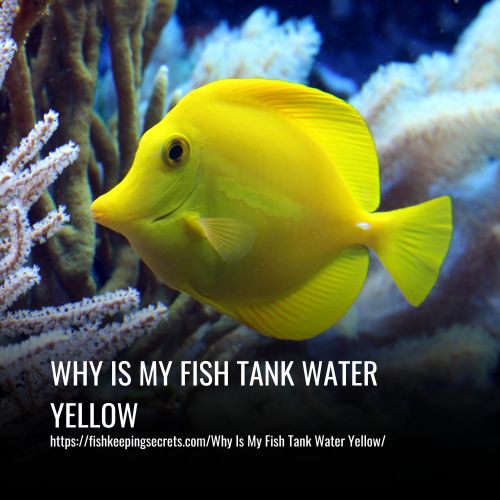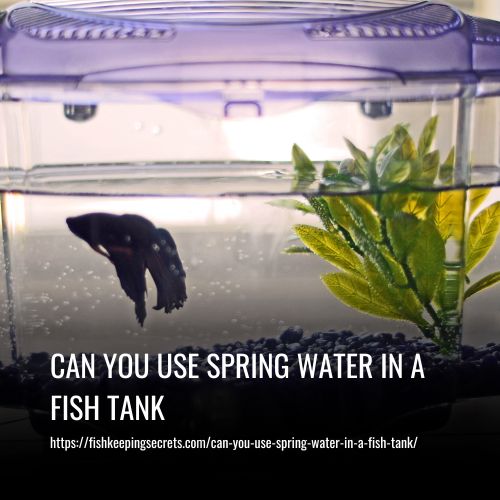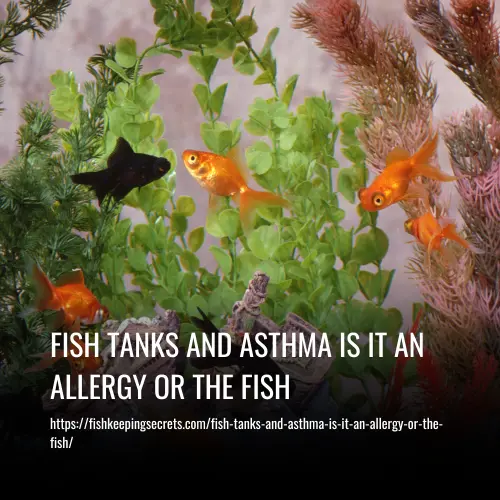There are several possible reasons for yellow aquarium water, including overfeeding, high levels of organic waste, inadequate filtration, excessive light exposure, and the presence of tannins from driftwood or other sources. It is important to identify the specific cause and take appropriate corrective actions to maintain clean and healthy water for your fish.
Other Causes of Fish Tank Water Yellow:
- Algae Bloom in the Water.
- Tannins.
- Fish Waste.
- Rotting Plants.
- Unwashed Substrate.
- Leftover Fish Food.
- Too Many Fish.
- Bacteria Growth.
- Organic Compounds.
- Driftwood Tannins.
- Unwashed Substrate.
- Lighting Period.

What Causes Aquarium Water to Turn Yellow/Murky?
Yellow aquarium water can cause several issues, from diminishing the aesthetic appeal of your tank to harming the health of your fish or plants. In order to keep your tank water clean and clear, it is important to identify what is causing the yellowing and take steps to address the issue.
1. Algae Bloom in the Water:
If your aquarium has turned yellow, it is likely due to an algae bloom. Algae blooms can cause the water to appear yellow or green and make it unsafe for the fish living in the tank. Algae grow quickly and can use up all of the oxygen in the water, making it difficult for fish to breathe.
To avoid this issue, it is important to maintain good aquarium hygiene by regularly replacing or cleaning out your filter media and performing regular water changes. Additionally, you should consider adding natural algae eaters, such as snails or shrimp, to help keep algae levels in check.
2. Tannins:
Tannins can have a major effect on the quality of the water in your fish tank. Driftwood can lead to an accumulation of tannins, leading to a discoloration of water with a yellow-to-grayish-to-dark-green hue.
This discoloration is caused by the tannins softening the water and potentially reducing its pH level, which could be desirable for certain fish species.
It is important to monitor the quality of your tank’s water regularly and make sure that any potentially hazardous substances are removed before they can affect your fish.
3. Fish Waste:
Caring for your fish tank involves more than just providing food and shelter. It is important to regularly clean the tank by removing any excess waste, such as uneaten food or fish poop. This will prevent the water from becoming polluted and yellow due to built-up waste in the tank.
In addition, installing a water filter can help keep the water clear by removing small particles before they settle in the tank. Keeping your tank clean and filtered not only prevents water discoloration but also helps to maintain a healthy environment for your fish.
4. Rotting Plants:
Brown or yellow water in a fish tank is an indication that there may be something amiss with the aquarium’s environment. This could be due to poor water quality, excess nitrates, or dead plant matter. It’s important to test the water regularly and do regular water changes to maintain healthy levels of oxygen and other environmental factors.
Also, keeping plants in your tank alive and well can help prevent this discoloration from occurring. Lastly, make sure that any decorations you add are safe for your fish; avoid adding any materials that could potentially harm them.
5. Unwashed Substrate:
When setting up your aquarium, it is important to keep the tank clean and safe by washing the substrate before adding it. This helps prevent discoloration of the water, which can occur if tannins or other pollutants are present in the substrate. Washing your substrate can also help remove dust particles that could affect your fish’s health and water quality.
Additionally, a good substrate cleaning can help you maintain clear water and ensure that your fish have a healthy environment to live in.
6. Leftover Fish Food:
Water with a yellowish tint can be indicative of an excess amount of organic compounds, resulting from overexerted fish food. Overfeeding your fish can be detrimental to their health, so it’s important to provide them with the right amount of food according to the species and size of your fish.
Additionally, ensuring good water quality by regularly checking the levels of ammonia, nitrites, and nitrates in your tank can help reduce the buildup of these compounds. Lastly, keeping up with regular water changes will help keep your tank clean and clear, giving you a healthy environment for your fish.
7. Too Many Fish:
An overstocked aquarium can cause a yellow tint in the water and an imbalance in chemicals. This imbalance can be dangerous for your fish and plants, potentially leading to their death.
To prevent this from occurring, it is vital to keep track of how many fish and plants are in your aquarium, as well as make sure that the tank is cleaned regularly. Maintaining the correct number of fish and plants will also help ensure good water quality, which is essential for healthy and happy fish.
8. Bacteria Growth:
Yellow water in your aquarium can be an indication of several problems. If the tank’s water is murky and tinted yellow, it could be a sign of unhealthy levels of bacteria growth. This can also be known as a bacterial bloom or blossom. In such cases, the water may appear gray or cloudy rather than yellow or green.
Other causes for yellow water may include unbalanced pH, high ammonia levels, high nitrite levels, fungus or algae growth, or poor water quality. It’s important to monitor your aquarium regularly to identify the cause and make any necessary changes to keep your fish healthy and their environment balanced.
9. Organic Compounds:
It is important to pay attention to the organic compounds in your aquarium, as they can be detrimental to the health of your fish. These compounds, which could include uneaten food particles, fish waste, and decaying plant parts, break down in the water and can give it a green or yellow tint.
This discoloration is usually accompanied by cloudy or murky water, unpleasant odors, and an overall lack of aesthetic appeal. To prevent these issues from arising, keep an eye out for signs of organic pollutants such as tinted water or unpleasant odors. As soon as you spot either of these signs, take steps to clean your tank and restore proper water quality.
10. Driftwood Tannins:
Certain types of wood, such as driftwood and bogwood, can release tannins into the aquarium water, resulting in a yellow tint. Tannins are acidic in nature and can also disrupt the pH level in the tank. Be aware of the pH preferences of your fish before adding any new wood to your tank and be sure to monitor your water quality regularly.
While water discoloration due to tannin levels is usually nothing to worry about, certain fish may find it beneficial as it mimics their natural habitat. Over time, the tannin levels in the water will naturally decrease and the yellow tint will dissipate on its own.
11. Unwashed Substrate:
When a new substrate is added to an aquarium, the water may become cloudy or take on a tinge. This is due to the dust particles that are present on the substrate and which get dislodged into the water when the substrate is placed in the tank. These particles can give a discolored appearance to the water and make it look cloudy. If you experience this, don’t worry – it’s natural!
12. Lighting Period:
In addition to the other factors discussed, lighting can also affect the clarity of your aquarium’s water. Longer periods of light can act as a catalyst for bacteria growth and soon lead to an overgrowth that can discolor the water in your tank.
To prevent this from happening, it is important to follow the recommended guidelines for proper lighting in your fish tank and make sure not to exceed the daily hours that your lights are on. Regular water changes and cleaning can also help to keep your tank clear.
What to Do About Aquarium Water Turning Yellow
The first step towards solving the issue of yellow aquarium water is to identify the root cause. Common causes of discolored water include too many fish, poor filtration, decaying organic matter, and insufficient aeration. Once you have identified the source of your discoloration, you can take steps to address it.
1. Change The Water Regularly:
If your tank has become discolored due to excess fish food or waste, it’s important to take steps to get rid of the buildup. You should perform regular water changes, replacing about a quarter of the water every two weeks. Make sure to do this slowly in order to avoid shocking your fish.
To maintain healthy water quality and happy fish, a vacuum cleaner can be used to clean the gravel or substrate in the aquarium during a water change. This will make sure that the water remains in good condition and the fish stay healthy.
2. Install a Water Filter:
To maintain good water quality in your aquarium, it is important to use a water filter that is correctly sized for your tank. Without a filter, waste and other contaminants will quickly accumulate in the tank and can cause discoloration of the water.
Additionally, using a filter that is too big or small may also affect water quality. It is important to research the right size filter for your tank so that you can ensure proper filtration and optimal water conditions.
3. Get Rid of Dead Plants:
When you notice discolored water in your aquarium it could be due to a number of factors, including decaying plants. It is important to remove any decaying matter from the tank as soon as possible to avoid further issues.
If you are unable to locate the source of the discoloration, a light cleaning and waiting a few days can help determine if the issue has been resolved. It is also important to make sure that the new water added when changing the water does not become contaminated.
4. Get Rid of Tannins:
Activated carbon is an effective way to reduce tannins and other compounds in your fish tank. The granules are treated with heat and chemicals to make them more reactive. When added to the aquarium, they will absorb harmful substances like tannins and discolored water, making the tank environment safer for your fish. It is important to ensure that the activated carbon used is not too fine as this could potentially block filters or clog up the live rock in your tank.
Additionally, make sure to replace the activated carbon every two weeks or so in order to maintain proper water quality.
5. Get Rid of Dead Animals:
If you’re noticing discolored water in your aquarium, the cause could be something as simple as decaying organic matter. This can be caused by dead fish that might have gone unnoticed or uncollected when they died. Make sure to regularly check around your plants and tank for any dead animals, as this can lead to an accumulation of toxins in your water.
Additionally, make sure you are doing regular water changes to help keep your aquarium clean and free of hazardous waste. Finally, aerating and filtration systems can help remove impurities from the water and ensure that it is properly oxygenated.
6. Clean the Water Filter:
If you notice that the water in your aquarium is cloudy or discolored, it could be a sign of too much decaying organic matter in the water. This can often occur when an aquarium filter isn’t doing its job properly. It’s important to inspect your filter regularly and to make sure there aren’t any blockages that are preventing it from cleansing the water effectively.
Additionally, weekly cleanings of your tank and filter should help reduce any build-up of waste and debris. If cleaning doesn’t solve the problem, you may need to invest in a more powerful filter for your tank.
7. Vacuum the Substrate:
There could be several reasons for the discoloration of your aquarium water. One potential explanation is the aquarium substrate, as new substrates can carry debris and contaminants if not properly rinsed before use. To make sure that your substrate is not the cause of the problem, try using a gravel vacuum or siphon to clean it out and remove any excess gravel that may be present.
Other sources of discoloration can include uneaten food or plant material, or even an imbalance in your tank’s chemistry. You may need to do an in-depth water test to identify any problems with pH or ammonia levels that may be contributing to the issue. To prevent further discoloration, make sure you are cleaning and maintaining your tank regularly and feeding only what your fish will eat.
8. Determine the pH Level of the Water:
If you notice that the water in your fish tank has become discolored, it may be a sign of tannins. Tannins are acids produced by driftwood or bogwood decorations, which can cause the pH level of the water to drop. The easiest way to deal with this problem is to remove the driftwood or bogwood decorations and replace them with something more suitable for your fish.
If the fish don’t mind a lower pH level, however, you don’t need to do anything – just wait for the discoloration to go away on its own.
9. Determine Ammonia, Nitrite, and Nitrate levels:
If you have high levels of ammonia, nitrite, or nitrate in your fish tank, it is important to take action immediately as these can be toxic to your fish. Replacing half of the water in the tank is a good first step as this will reduce the level of toxins in the water by half.
After replacing the water, it’s important to test again for ammonia, nitrite, and nitrate levels to make sure they are back within safe limits. It’s also important to check any decorations or plants in the tank for signs of decay which can contribute to elevated toxin levels.
Lastly, regular maintenance and water changes are key to keeping your tank healthy and thriving.
10. Cleaning the Aquarium:
Keeping your aquarium clean is essential for ensuring the health and happiness of your fish. You should regularly check for any debris that may be floating in the tank, and make sure to keep the walls of the tank wiped down from the inside.
In addition, cleaning and replenishing your aquarium substrate is necessary to ensure optimal water quality. By taking these steps, you can help keep your fish healthy, vibrant, and active.
11. Check the Filter:
A healthy tank requires that the filter is running properly at all times. Without proper filtration, the quality of your water can quickly deteriorate and cause stress on your fish. It’s important to check the filter regularly for signs of damage or clogging, and clean or replace it when necessary.
Additionally, it’s important to make sure that you are cleaning any accumulated waste from the tank and performing regular partial water changes. This will help keep the aquarium environment healthy for your fish and improve their overall quality of life.
What To Avoid Doing When You Have Yellow Aquarium Water
- Avoid overfeeding your fish: Overfeeding can cause uneaten food to rot in the tank, creating an excess of unwanted bacteria that can turn the water cloudy and yellow.
- Don’t change too much of the water at once: If you add too much new water too quickly, it can shock your fish and cause a change in their pH levels, resulting in yellow-tinted water.
- Don’t use soap to clean the tank: Soap residue left behind from cleaning can turn your tank’s water yellow and make it dangerous for your fish to live in.
- Don’t mix different types of gravel: Different gravels may contain minerals that react with each other and release compounds into the water, turning it yellow or cloudy.
- Do not ignore regular maintenance: Regularly check your filter to make sure it is clean and clear, as a dirty filter can lead to the yellowing of the tank water. Change out 20-25% of the tank’s water weekly and vacuum the substrate to remove any buildups of waste or particles that could be contributing to the color issue.
FAQs
No, yellow water is not good for fish. Yellow water is a sign of too many nitrogen-containing compounds, also known as ammonia and nitrates, which can cause significant stress for the fish and lead to death in some cases.
It is important to regularly monitor your fish tank’s pH and temperature levels to ensure healthy living conditions for the aquatic inhabitants.
Organic matter decomposition in aquariums can lead to an increase of ammonia and nitrates that can cause the water to yellow.
Discoloration of the water in an aquarium can be a sign of organic matter or dead leaves, potentially making it unsuitable for fish.
Ion exchange resins can be used to treat water in aquarium tanks that have become yellow due to overfeeding. The resins attract ammonia and nitrates from the water, as well as compounds that make the water yellow and convert them into less dangerous substances.
Driftwood can cause tannins to leach into the aquarium water, leading to a yellow-brown discoloration. Additionally, these tannins can lower pH levels and reduce water hardness, which may be helpful for some fish species according to The Spruce Pets.
Many aquarium owners have yellow water in their tanks at some point. This can be normal and easily solved, however, if it is unexpected then the root of the problem needs to be investigated.
Poor cleaning or an imbalance in diet and water quality could lead to discoloration and affect the health of fish. To ensure the tank looks its best and keeps the fish healthy, regular cleaning, a balanced diet, and good water quality should all be maintained.
Conclusion:
Having a yellow tank is not something you want, so it’s important to prevent this from happening in the first place. If your water already appears to be yellow, then it’s time to take action before the situation further worsens.
Before you add chemicals or carry out any treatments, test for potential problems such as a high nitrate level. Once you’ve identified and corrected the issue, your fish tank will look as good as new.



